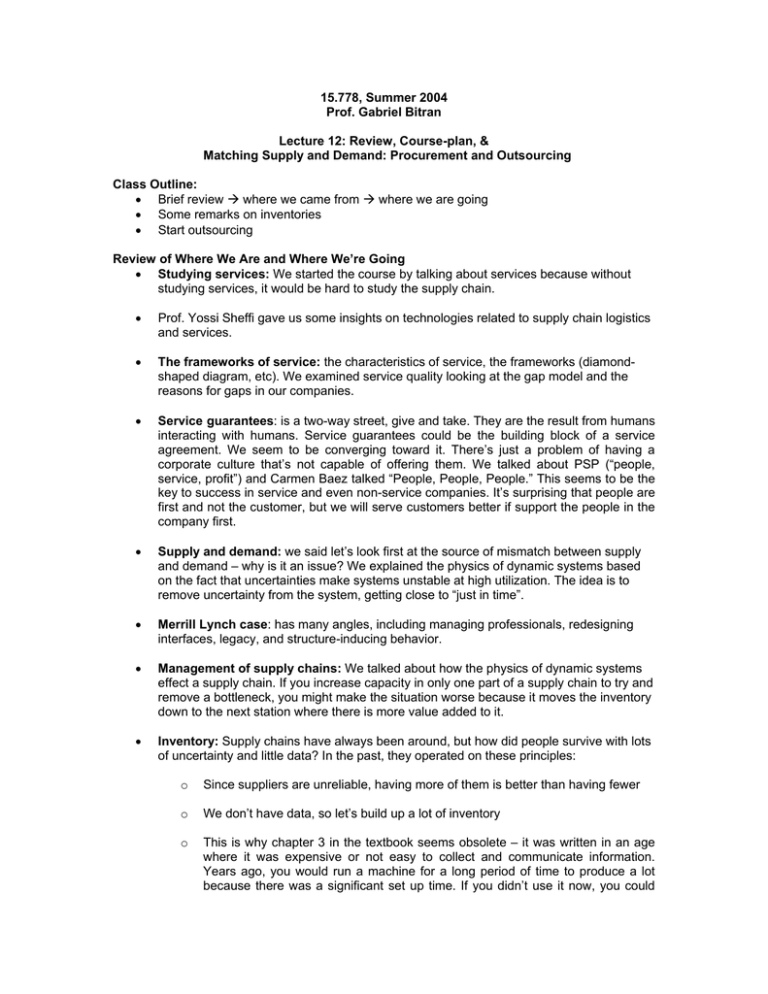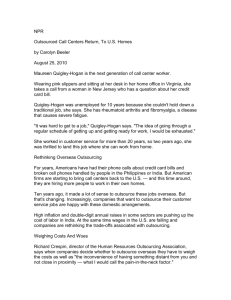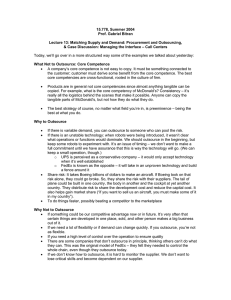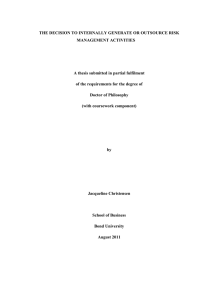15.778, Summer 2004 Prof. Gabriel Bitran Lecture 12: Review, Course-plan, &
advertisement

15.778, Summer 2004 Prof. Gabriel Bitran Lecture 12: Review, Course-plan, & Matching Supply and Demand: Procurement and Outsourcing Class Outline: • Brief review Æ where we came from Æ where we are going • Some remarks on inventories • Start outsourcing Review of Where We Are and Where We’re Going • Studying services: We started the course by talking about services because without studying services, it would be hard to study the supply chain. • Prof. Yossi Sheffi gave us some insights on technologies related to supply chain logistics and services. • The frameworks of service: the characteristics of service, the frameworks (diamondshaped diagram, etc). We examined service quality looking at the gap model and the reasons for gaps in our companies. • Service guarantees: is a two-way street, give and take. They are the result from humans interacting with humans. Service guarantees could be the building block of a service agreement. We seem to be converging toward it. There’s just a problem of having a corporate culture that’s not capable of offering them. We talked about PSP (“people, service, profit”) and Carmen Baez talked “People, People, People.” This seems to be the key to success in service and even non-service companies. It’s surprising that people are first and not the customer, but we will serve customers better if support the people in the company first. • Supply and demand: we said let’s look first at the source of mismatch between supply and demand – why is it an issue? We explained the physics of dynamic systems based on the fact that uncertainties make systems unstable at high utilization. The idea is to remove uncertainty from the system, getting close to “just in time”. • Merrill Lynch case: has many angles, including managing professionals, redesigning interfaces, legacy, and structure-inducing behavior. • Management of supply chains: We talked about how the physics of dynamic systems effect a supply chain. If you increase capacity in only one part of a supply chain to try and remove a bottleneck, you might make the situation worse because it moves the inventory down to the next station where there is more value added to it. • Inventory: Supply chains have always been around, but how did people survive with lots of uncertainty and little data? In the past, they operated on these principles: o Since suppliers are unreliable, having more of them is better than having fewer o We don’t have data, so let’s build up a lot of inventory o This is why chapter 3 in the textbook seems obsolete – it was written in an age where it was expensive or not easy to collect and communicate information. Years ago, you would run a machine for a long period of time to produce a lot because there was a significant set up time. If you didn’t use it now, you could save the items for later. And if the demand doesn’t come, we’ll sell the products harder. We were looking in a myopic way at that one machine: we focused on lead time and set-up costs, even when there was a great deal of uncertainty in the system. We used a lot of buffers in between machines in case of a breakdown. This is nonsense because with preventative maintenance, we shouldn’t have a breakdown. We used to be driven not by demand but by forecasts. These push systems indeed became very inefficient because they’re highly unrelated to the market demand patterns and signals. o Longer production lead times imply more uncertainty than shorter ones since forecasts are related to production time. Smaller lead times imply lesser inventory and less of a need for forecasting. o Today, companies have backed up to the design phase: fix problems there instead of fixing them on production floor. Design now integrates customer and production needs. This is very different than the introverted, isolated role of a designer in years past. o Instead of pushing, we’re now pulling production to meet demand o How do you reduce lead time? Eliminate uncertainty and make the system more predictable. o Society has become very good at manufacturing. It’s hard to find a company that’s bad at manufacturing because it wouldn’t survive. How do I differentiate myself as a company? Service. Being good at manufacturing is only a necessary prerequisite for being in the game, but service will differentiate companies. Outsourcing Here is a small example that we’ll explain in the next session: I worked with a small Brazilian investment bank with a bright president. The bank was currently doing well, but the president looked ahead and realized that with the American banks coming into Brazil, his company wouldn’t do well. The American banks have sources of capital that the Brazilian bank doesn’t have. The president thought he needed to get into an area in which they could have a competitive advantage, so he chose retail banking since it is dependent on knowing the local culture. He bought a large bank in the south and also wanted to offer a credit card service. To do that, he needed: a distribution channel to attract customers, merchants to accept the card, a processing agency, and a collection agency. The president named someone in his company to oversee the project, but it ran into some problems. So, I offered to help my friend the bank president; as part of my initial work, I tried to apply for one of his cards in a shopping mall. I went there and didn’t find them in the booth, since that operation had been outsourced. I looked at the call center, which had also been outsourced. The customers were not doing well but the customer representatives did not care. Every step was subcontracted and no step of supply chain was the way it was supposed to be. The question is: how could a group of smart people make such a tremendous mistake? We’ll come back to it tomorrow. Class Discussion of the Outsourcing Assignment Students share their experiences with outsourcing: - Building computer connectivity and software for stock trading systems: We had to consider the possible legal implications if one trader was perceived to be favored by the software over another trader. If we were going to be held responsible for our software, do we really want to outsource it? - Software firm: We needed a source of talent and we needed more capacity, so we began to consider outsourcing our engineering operations abroad. Even though outsourcing was - - - - - less expensive than hiring local engineers, we faced questions of if we trusted the other company and what standards of quality they had. In the end, we decided maintenance and testing were lower priorities than our company’s true focus, which is making cutting edge software. Startup firm: We had to judge the motivation and reliability of the suppliers, intellectual property problems, buying product capacity, economies of scale, and other issues in our decision to outsource or not. My company outsourced our software needs years ago because we decided it was “not our business”. There were cost savings, but there are also many hidden costs of outsourcing: working with a team far way, working across cultures, and managing suppliers. Data networking hardware: We decided to focus on the areas where we could add value best and kept those functions inside, while moving other tasks offshore. My company decided to take the competition off the street by outsourcing to a vendor who is also a competitor. We used outsourcing to promote innovation – several different companies sent proposals to us, and we could choose the best at the lowest price. Questions that will form the framework for outsourcing: 1. what not to outsource 2. what to outsource 3. why to outsource 4. w hy not to outsource 5. if we outsource what do we need We will talk more about this in our next session.








